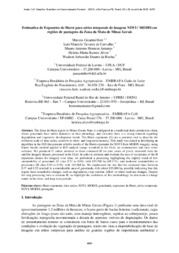Estimativa de expoentes de Hurst para séries temporais de imagens NDVI / MODIS em regiões de pastagens da Zona da Mata de Minas Gerais.
Estimativa de expoentes de Hurst para séries temporais de imagens NDVI / MODIS em regiões de pastagens da Zona da Mata de Minas Gerais.
Author(s): HOTT, M. C.; CARVALHO, L. M. T. de; ANTUNES, M. A. H.; ALVES, H. M. R.; ROCHA, W. S. D. da
Summary: The Zona da Mata region in Minas Gerais State is configured in a traditional dairy production chain, whose grasslands have subtle dynamics in their phenology, and currently there is a strong concern regarding degradation and vegetative development trends. The Hurst exponents (H) are a potential tool to describe the evolution scale of time series, sensitive to short- and long-term memory. This study was aimed at developing an algorithm in the GIS that presents reliable results of the Hurst exponents for NDVI from MODIS imagery, using binary blocks method applied to R/S analysis (range rescaled) in the Gretl, an econometrics and time series software. We produced H values identical to those estimated H for time series of pixels extracted from the satellite imagery dataset, processed in the Gretl. In order to estimate and evaluate the area of occurrence of the H exponents classes for imagery over time, we performed a processing highlighting the slightly trend of low sustainability of grasslands (H class 0.52 to 0.65), with 833,768 ha (68.71%), and moderate sustainability or persistence (H class 0.65 to 0.70), with 162,068 ha. We emphasized the fact that the estimated class between 0.37 and 0.52 resulted in a considerable area of grasslands, with about 135,000 ha, possibly indicating that this region faces remarkable changes, such as degradation, crop rotation, fallow or others land use changes. Despite the long processing time to estimate H, we highlight the usefulness of this methodology for detection of change trends in the short- and long-term periods.
Publication year: 2015
Types of publication: Paper in annals and proceedings
Unit: Embrapa Coffee
Observation
Some of Embrapa's publications are published as ePub files. To read them, use or download one of the following free software options to your computer or mobile device. Android: Google Play Books; IOS: iBooks; Windows and Linux: Calibre.
Access other publications
Access the Agricultural Research Database (BDPA) to consult Embrapa's full library collection and records.
Visit Embrapa Bookstore to purchase books and other publications sold by Embrapa.

